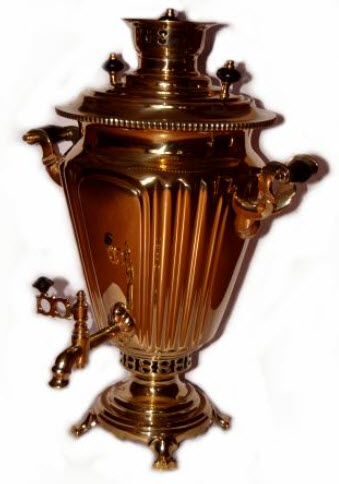What tea professionals need to start the week —
Weathering the retail storm…Tea growers in Sochi share a cup with Olympic Winter Sports spectators and press… Art of Tea CEO Steve Schwartz sounds secure on CNBC… tea offers a welcome relief to snifflers during the latest cold snap... India sets production record in 2013 of 1.2 million metric tons of tea…Rishi Tea breaks ground on a 50,000 sq. ft. facility that opens in late summer.
A Cold Blow
January delivered a cold blow to retailers following a chilly December. Sales for the month declined in the U.S. by .4 percent which added to a somber .1 percent drop in December, according to U.S. Commerce Department figures. December sales were previously reported as positive.
Explanations for the declines varied — job growth slowed, consumer confidence waned, sales of new autos fell and wage gains are stagnant following a strong fourth quarter — but economists could all point a finger at the unusually cold weather.
Snowfall in January across the U.S. was almost four times greater than normal, according to HAM Weather. There were 1,073 snowfall records and 4,406 new cold temperature readings during the month, mainly in the eastern seaboard, Mississippi Valley and southeastern states. New York City reported 8 inches of snow in Central Park on Feb. 4., a record for the date while Chicago received 33.7 inches during January. It was the coldest January since 1994 on average based on a measure of energy demand. The Northeast is on track for the coldest winter since 1982 based on December to February temperatures.
Meanwhile in the West, cities in California and Arizona and the Pacific Northwest recorded 783 record highs during the month.
The Commerce Department said that spending at department stores decreased 1.5 percent in January. Foot traffic at malls continued off pace and McDonald’s Corp. said that same-store sales fell for the third straight month in January, blaming both the weather and declining consumer confidence.
February is looking up somewhat. The Thomson Reuters/University of Michigan index of consumer sentiment is stronger than projected for February, according to Bloomberg.
Sources: Bloomberg TV, HAM Weather

Tea Growers Welcome Olympic Tourists
SOCHI, Russia — Reporters at the Olympics said they are enjoying tea and biscuits at a tea stall developed by people from Russia’s Kuban region. The region, which includes Sochi, is home to several tea gardens.
A reporter for the Boston Globe noted the tea corner in the media center is very popular with the press:
“Women (in traditional costume) pour piping hot cups of black tea, then serve the drink with piles of biscuits, cookies, and packets of honey. For free. “With love from the Kuban people,” the women say.
A Russian peasant who developed a winter-resistant tea hybrid in 1901 established Sochi as an important domestic supplier in a nation of tea drinkers. The region’s six gardens produce about 2,000 metric tons of tea.
Russia imports the largest quantity of tea in the world to serve a population that likes its tea full-bodied and hot. Russians consume 3 pounds of tea per capita to rank 4th behind England among the world’s tea drinkers.
Visitors to the Olympic Games in this Black Sea resort town are discovering Sochi has a long history of tea growing and several tea chalets including the two-story Sochi Tea House where visitors can enjoy locally grown black teas. Tours also stop at the Museum of Samovars and include a tea party in a Russian wooden Izba.
 Tea drinkers will find the ever-present samovar in area restaurants and homes. This large urn is designed to keep water hot and tea on the boil in a kettle at the top of an internal chimney. Today’s samovars are electrically heated but old style samovars have a fire bin where coal, charcoal and small sticks were burned for heat. The concentrated tea is then diluted about 10:1 and mixed with jam or lumps of raw sugar.
Tea drinkers will find the ever-present samovar in area restaurants and homes. This large urn is designed to keep water hot and tea on the boil in a kettle at the top of an internal chimney. Today’s samovars are electrically heated but old style samovars have a fire bin where coal, charcoal and small sticks were burned for heat. The concentrated tea is then diluted about 10:1 and mixed with jam or lumps of raw sugar.
Green tea is preferred in the region bordering China but the people of Eastern Russia are largely black tea drinkers who sometimes place a cube of sugar in their mouth as they sip.
Vyacheslav Moroz, director of the Dagomy-chai tea garden, told USA Today that Sochi tea is grown with little interference from pests as the cold weather proved fatal to insects and also prevents the growth of many tropical blights, fungus and diseases. Tea is ecologically farmed, clean of pesticides, certified organic, harvested mechanically and sold internationally.
The tea is known as Krasnodar Tea after Judas Antonovich Koshman, the Ukrainian peasant whose plants stocked Sochi’s first successful tea plantation in 1905. It is the northernmost commercial growing region for tea in the world.
Tsar Nicholas II owned a large cattle farm and botanical garden in Dagomys, a section of Sochi about 870 miles south of Moscow. Located along the Black Sea coast with the Caucasus Mountains nearby, this former military outpost became a resort for the wealthy. Since 1689 tea was largely imported from China along an 11,000 mile trade route and very expensive, according to the Liberty Voice. Tea was first introduced in Russia in the mid-1600s as a gift from Mongolia to Tsar Michael I and was used by the nobility for medicinal purposes.
“By the late 1700s, tea was gaining acceptance in Russian society which brought the prices down. It was during this time that the first factory production began of the uniquely Russian “teapot,” the samovar,” according to the Liberty Voice.
Tea growers that settled near Sochi were unsuccessful in the 1870s and 1880s due to the winter weather. The Tea Museum in Sochi tells the story of a Russian expedition in 1896 that purchased 2,000 kilos of Chinese tea seeds but fewer than 5% germinated. Koshman experimented with the stock and managed to grow 800 bushes in Solokh-Aul, a fertile region about 30 kilometers south of Sochi protected from the harsh winter.
Full scale commercial production began in 1936 in Dagomys-chai. By the 1980s the 5,000-acre garden was one of the largest suppliers of tea to the Soviet Union.
Source: Boston Globe, USA Today, Liberty Voice, Tula Museum of Samovars,
Invest in Security
Art of Tea founder Steve Schwartz was interviewed recently on matters of cyber security. His advice to small business owners: Invest in online security.
Schwartz told a CNBC reporter that security is a priority because cybercriminals don’t discriminate based on business size. “We’re just as sensitive and susceptible to what’s happening with Neiman Marcus,” he said.
The Los Angeles-based tea importer and wholesaler said that his company’s online security software costs about $100 per month, plus an additional charge per online transaction. The system issues an alert when there is suspicious activity.
Two members of his staff of 25 monitor online security since the bulk of his business is online, he said.
CNBC reported that “roughly 77 percent of small firms believe their company is safe from a cyberattack — even though 83 percent of those firms do not have a written security policy in place, according to the National Cyber Security Alliance.”
Consumers are concerned following several high-profile breeches involving sensitive credit card transaction and personal information. According to security experts those who become victims switch banks, switch credit cards providers and they switch retailers.
Source: CNBC
Quell Winter Sniffles with Cup of Hot Tea
It is the season of snow angels, skiing and skating, and coughs and colds. When nasty sicknesses hit, many turn to the tea cabinet. While no tea or herbal remedy can cure a virus, some of them may be able to offer some comfort from the symptoms.
Sore throats can always benefit from warm liquids, so choosing tea is a natural. A dose of honey in the cup can help coat and calm a ticklish throat. Because lemon has natural antibacterial properties, some believe it can help fight the effects of illness. It is also possible that its acidity changes the general environment within the throat, impacting uncomfortable sensations. Licorice root tea helps to reduce inflammation and chamomile may help to relax muscles, easing pain. Tea’s flavonoids also offer anti-inflammatory properties.
Sinus pain is frustrating and uncomfortable. Ginger is a great help when congestion takes hold. The spicy smell opens stuffed sinuses. It also helps to loosen mucus and can serve to increase circulation. Cinnamon’s powerful aroma can also help open up those sinuses as well.
As tempted as one might be, cold sufferers shouldn’t sip too hot a cup or it may burn the throat, increasing discomfort, rather than easing it.
Read more about home remedies here.
Rishi Breaks Ground on Warehouse
MILWAUKEE, Wis. – Rishi Tea broke ground on a new 50,000 sq. ft. office, warehouse and blending facility last week
“We’ve laid a foundation for respect in the tea market, a respect for our quality distinction and innovative approach to tea making. Building this facility represents a renewed investment in our foundation – our customers. It also will enable us to improve our ability to deliver the very best tea products in the world,” said Joshua Kaiser, Rishi Founder and CEO.
The new building, located in the Menomonee Valley industrial park, is expected to be completed by mid-August. It is situated on a 3.8 acre site. The company last moved eight years ago when it leased a 13,000 sq. ft. property and quickly expanded to 38,000 sq. ft. of leased space. It has since outgrown its current home.
“We’re more than completely out of room,” Rishi Co-owner and Vice President Benjamin Harrison told the City of Milwaukee’s Redevelopment Authority in July. “We’re bursting at the seams and storing a lot of product off-site. … Quite simply, we are out of space, and we need to grow.”
Rishi now shops to 50 states and 10 countries. “We’re an international company with roots in Milwaukee. The decision to build a production facility here was very important to us. We’re glad to stay in our hometown,” said Harrison.
 Briohn Building Corp. Brookfield, Wisconsin, is responsible for architectural design and construction of the pre-cast concrete structure. “They’ve understood our goals and are making it possible for us to achieve them,” said Harrison.
Briohn Building Corp. Brookfield, Wisconsin, is responsible for architectural design and construction of the pre-cast concrete structure. “They’ve understood our goals and are making it possible for us to achieve them,” said Harrison.
Although the new facility is only 10,000 sq. ft. larger than the space it current occupies, Harrison said Rishi will be able to use the space much more efficiently due to the building’s 24-foot clear height and layout.
In a report in the Milwaukee Sentinel, Harrison said the company currently employs 46 and “could easily add 20 more in the next five years.” The firm is growing at a rate of 10% per year, he said. The building could eventually be expanded by 20,000 to 30,000 sq. ft.
Rishi Tea obtained $1.86 million from a city-affiliated lender to help finance the project. The Redevelopment Authority sold the land for $120,000 per acre.
Sources: Rishi Tea, Milwaukee Business Times, Milwaukee Sentinel
India’s Domestic Consumption
MUMBAI, India – Thanks to the Herculean efforts of India’s small tea growers, the country is approaching China as the world’s largest tea producer.
The Indian Tea Association proudly declared this week that overall production grew by 6.5 percent last year for a record 1.2 million metric tons of tea. Small growers contributed more than 30% of the total according to India Tea Board estimates. India was the dominate producer and exporter for many years but China has since invigorated its production and desire to export.
Last year China produced about 1.75 million metric tons and is expected to produce at least 1.8 million metric tons in 2013 but an official total has not been released. China accounted for 35 percent of the world’s tea in 2012 and India accounted for about 21 percent of the 4.3 billion kilos produced. Kenya and Sri Lanka are distant third and fourth, each producing less than .375 million metric tons. Unlike China and India, relatively little tea is consumed in Kenya making it the largest exporter of black tea. China is the largest exporter of green tea.
China also has a much more robust tea manufacturing, bottling and packaging sector than India. Revenue for China’s Tea Production industry has been increasing at an annualized rate of 17.4 percent to an expected $14.7 billion in 2013. The industry has increased its share of China’s beverage market over the past decade to about a quarter, according to IBISWorld.
Kenya is the world’s largest black tea exporter but adds value to only 8% of its exports while India, the region’s other tea powerhouse adds value to only 11% of its tea exports.
The production increase had little impact on India’s exports however as the majority of this tea was CTC grade and virtually all was consumed by the fast-growing domestic market. India exports CTC mainly to Egypt, Pakistan and the U.K. with orthodox production to Iraq, Iran and Russia. North America is generally the fifth or sixth largest ranked export destination but demand here continues to increase.
Domestic consumption reached 856 million kilos in 2011 and 875 million kilos in 2012. Final numbers are not available but the Tea Board estimates consumption will top 880 million kilos. Growth continues at 2% to 3% annually which will mean India will have to begin importing tea to meet its domestic demand and maintain export targets. Per capita consumption rose to 718 grams (1.58 pounds) in 2011, about triple the U.S. Domestic consumption is rising steadily from a per capita count of 654 grams (1.44 pounds) in 2001.
Assam continues to lead the nation’s five growing regions with an April-December harvest of 607 million kilos, up 5% compared to the previous year. West Bengal tea growers increased yield by 11% to 290 million kilos according to Tea Board data.
The southern growing regions of Tamil Nadu, Kerala and Karnataka showed a 16% increase for the period to 196 million kilos.
Sources: Economic Times the Business Line and China Daily
— — —
Tea Biz serves a core audience of beverage professionals in the belief that insightful journalism informs business decision making. Tea Biz reports what matters along the entire supply chain, emphasizing trustworthy sources and sound market research while discarding fluff and ignoring puffery.
Tea Biz posts are available to use in your company newsletter or website. Purchase reprint and distribution rights for single articles or commission original content. Click here for details.



